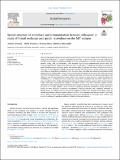| dc.contributor.author | Sevtsuk, Andres | |
| dc.contributor.author | Chancey, Bahij | |
| dc.contributor.author | Basu, Rounaq | |
| dc.contributor.author | Mazzarello, Martina | |
| dc.date.accessioned | 2024-08-21T20:28:24Z | |
| dc.date.available | 2024-08-21T20:28:24Z | |
| dc.date.issued | 2022-07 | |
| dc.identifier.uri | https://hdl.handle.net/1721.1/156357 | |
| dc.description.abstract | How does the spatial structure of work environments affect social interactions among workers? Building on prior studies of both physical and electronic communication networks, we present the results of a study conducted on the MIT campus using an anonymized dataset of e-mail communication to examine how spatial relatedness between faculty, staff, and researchers’ office locations impact E-mail communication between them. Our findings suggest that (a) people whose offices are closer to each other by walking are more likely to exchange E-mails, (b) on the campus as a whole, people who are more likely to walk past each other’s offices on the way to or from work are more likely to exchange E-mails, and (c) people who share access to similar eating venues around their offices are more likely to exchange E-mails. However, when controlling for unobserved relationships within departments and research units, a higher likelihood of physical encounters on the way to one’s office can reverse the effect of E-mail exchange, potentially substituting electronic communication for physical interactions with colleagues who are encountered more often. Further, the existence of social ties can be negatively affected by crowdedness, i.e., the chances of communication are reduced when encounters with each other’s offices occur in more crowded corridors. On the other hand, crowdedness at eating venues has a positive effect. E-mail exchange is also more likely if researchers are connected via indoor corridors along MIT’s renowned “infinite corridor” network than if the physical connection between them requires crossing an outdoor space. The key innovations presented in the paper include a novel approach to analyzing encounter probabilities during participant’s journey to work; estimation of potential crowdedness in building corridors; and a similarity estimation in amenity access for different workers. Our analysis suggests that these types of spatial relationships, which go beyond simple distance between workers’ offices, can affect E-mail communication between workers. The results provide limited evidence that spatial planning may be used strategically to encourage social, cultural, and economic exchange or knowledge-spillovers within buildings and campuses. | en_US |
| dc.language.iso | en | |
| dc.publisher | Elsevier BV | en_US |
| dc.relation.isversionof | 10.1016/j.socnet.2022.03.001 | en_US |
| dc.rights | Creative Commons Attribution | en_US |
| dc.rights.uri | https://creativecommons.org/licenses/by/4.0/ | en_US |
| dc.source | Elsevier | en_US |
| dc.title | Spatial structure of workplace and communication between colleagues: A study of E-mail exchange and spatial relatedness on the MIT campus | en_US |
| dc.type | Article | en_US |
| dc.identifier.citation | Sevtsuk, Andres, Chancey, Bahij, Basu, Rounaq and Mazzarello, Martina. 2022. "Spatial structure of workplace and communication between colleagues: A study of E-mail exchange and spatial relatedness on the MIT campus." Social Networks, 70. | |
| dc.contributor.department | Massachusetts Institute of Technology. Department of Urban Studies and Planning | |
| dc.relation.journal | Social Networks | en_US |
| dc.eprint.version | Final published version | en_US |
| dc.type.uri | http://purl.org/eprint/type/JournalArticle | en_US |
| eprint.status | http://purl.org/eprint/status/PeerReviewed | en_US |
| dc.date.updated | 2024-08-21T20:20:24Z | |
| dspace.orderedauthors | Sevtsuk, A; Chancey, B; Basu, R; Mazzarello, M | en_US |
| dspace.date.submission | 2024-08-21T20:20:27Z | |
| mit.journal.volume | 70 | en_US |
| mit.license | PUBLISHER_CC | |
| mit.metadata.status | Authority Work and Publication Information Needed | en_US |
